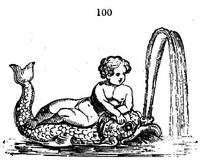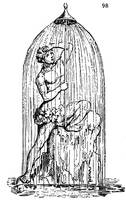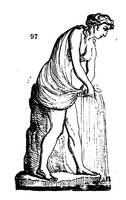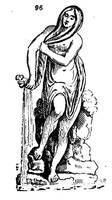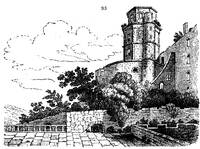352. The castle of Heidelberg is celebrated for the beauty of its situation, on a hill rising almost abruptly from the Neckar; and, in gardening, for the orangeries and Other garden structures that were created here, in the beginning of the seventeenth century, by the celebrated Solomon de Caus, architect and engineer to the Elector Palatine, and author of Hortus Palatinus Heidelberg� exstructus, Franc., 1620. The greater part of the ruins is in a mongrel Roman style, only interesting from its antiquity and from its situation: some other parts, and especially what is called the octagon tower (fig. 95.), are better. The walks through the grounds and among the ruins, though of very limited extent, are romantic, and display varied and extensive prospects of the vale of the Neckar and its bordering hills, covered with vineyards or woods along the principal-walks, which are open to the public at all times. There is a collection of hardy trees and shrubs, named after Linn�us, and in German; and, in a space, called the agricultural ground, there is a collection of European Cerealia, made by the distinguished botanist and curator of the botanic garden, (Metzger, the author of Europaische Cerealen, 1824, Heidelberg, folio,) who lives in a habitable part of the ruins. The gardens of Heidelberg in 1619. As a curiosity in the history of gardening, we shall here give a translation of the whole of the letterpress of the work of Caus above referred to, and illustrate it with a few of the thirty figures given in the original: � 'At the return of his majesty from England, from whence he brought his queen, it was his pleasure to have all the parts of his castle of Heidelberg put in order (intending to make it his usual abode), as well as a garden adorned with every possible variety. But as all things are subject to change, it has pleased God to raise this prince to the sovereignty of Bohemia, which has caused a delay in the works of the said garden. However, this has not prevented me from publishing the drawings of the said garden; those that are finished, as well as those that are still to be done. Now, this said castle is situated about 300 feet perpendicular above the city; and, on account of the mountains, which ascend much higher still, a plain of only 200 feet square can be found near to the said castle: for this reason, the preceding electors had had their garden made below, in the suburb of the city, which was very inconvenient. His majesty, then, having resolved to have some place levelled, fit for making a new and spacious garden, it was his pleasure to do me the honour of giving me the charge of it. I began with the little plain already there (which may still be recognised in the iconography, in which are the covered arbours, otherwise called leafy), and making the said garden on different stages, according to the declivity of the mountain. But what is much to be observed in this work, is the great difficulty of removing the rocks, of which the greater part of the mountain is composed; and the said rocks are so solid, that scarcely any fissures are to be found to facilitate the breaking of them, as are seen in freestone. But his majesty would not give up his design for these difficulties; therefore, with expense and labour, we have arrived, in the present month of November, 1619, very near the accomplishment of all the work; and if it had not been for the present wars, the whole might have been done in about six months. ' Description. 'Therefore, to begin to make a description of all that is most exquisite, and of what is to be when the whole shall be finished, I shall begin with the two great plans:�the one, of all the gardens; the other, of the scenography, or perspective, of the said garden, with part of the city and the surrounding country: and as these two plans may not be sufficient to show all the particulars of the whole work, I have made individual plans, from the first of which may be seen one of the parterres of the garden, in which is situated the fountain de la Colonne, which was the first done. A valley passed through the said parterre, which was 62 feet deep at the palace of the pillar, so that it was necessary to fill it (as was the case with the greater part of the rest) with the rock which was cut from the higher sides. The said pillar throws the water all round, falling in drops on the surrounding masses of rocks. Near to the said parterre there is another of similar size, in embroidery patterns, round which are eight Muses, and one, in the middle, called Urania. The latter shows the hour with a rod, by means of the shadow of the end of the said rod, when the sun shines. The other parterre following, is a compartment, the borders of which are of freestone, raised two feet, and filled with earth within. This parterre serves to put a part of the moveable orange trees in, when they are taken out of the stove; and between these orange trees melons may be sown. Then comes a parterre d'eau quite near, in which there are five figures as large as life; viz. one in the middle (fig. 98.), who holds a kind of parasol over his head, whence issues a quantity of water; two figures of women, one of whom wrings her hair (fig. 96.), and the other her chemise (fig. 97.), the water issues from the hair and from the chemise. The two others are two children upon sea monsters, which throw out water from their nostrils. ' (Figs. 99. and 100.) 'The orangery follows, in which there are thirty large orange trees, each about 25 feet high, and about 400 others, both middling-sized and small. These orange trees are about sixty years old; they were brought of this size from the garden below, and carried up the mountain with great labour, and the earth around them, the roots preserved in the cases made on purpose; a thing which was thought impossible by most people. This orangery is 280 feet long and 32 wide; and it is made of wood, which is put up every year about Michaelmas, and the orange trees are warmed by means of four furnaces all the winter; so that, in the time of the great frosts, one can walk in this orangery without feeling any cold, on account of the heat which proceeds from the furnaces. At Easter the framework is taken away, to leave the trees uncovered all the summer. On account of the difficulty of putting up this frame, and of the expense of keeping it in repair, I advised his majesty to have the orangery covered with a construction of freestone, so that in winter, the roof being already covered it was only necessary to close the windows, and thus much wooden-work might be spared, which often requires repair and keeping in order. The holes that are drawn in the four pilasters are for the escape of the water when it rains. The pillars should be all in the shape of trunks of trees, with ivy round them. 'The flower-garden is 460 feet long and 200 broad. The round parterre in the middle is divided into four parts, for the four seasons of the year; and each of these parts contains nine double beds, which, divided into three parts, will be, each month of the year, three double beds of flowers, which flower in the month; for it is certain that flowers may be had all times of the year. I have represented, in drawing, the fountain which is in the middle of this parterre, which should be ornamented with rocks and other rustic things. At the bottom of this garden there is a large summer-house, 88 feet long and 70 broad. It is still unfinished, on account of the Bohemian wars. There is, besides, the garden on the lowest stage, different from all the others; the parterres of which are all in embroidery patterns, and the walks raised two feet, by means of a border of freestone all round: at the angles of these parterres are put, in summer, orange trees and other portable shrubs. In the middle of this garden there is a small fish-pond, which receives generally all the water of the gardens; and two large figures, representing the two rivers, viz. the Main and the Neckar, exactly opposite each other, and the water issues from the rock which is near them. To return to the higher stage: there is, besides, a fountain in the flower-garden similar to that of the pillar which is at the entrance of the garden, which is to be ornamented with rocks and some compartment of shells, with four spouts of metal in the form of shells. In the higher stage, above the large door, there are several covered arbours; but the four in which are the twisted columns are seen above the others, by being placed in a situation from whence can be seen almost all the garden. In these arbours are also fountains, the water of which runs into a stair of an extraordinary form, in which there are pedestals on both sides, where the water descends from one to the other, and then runs off to the small fish-pond above the grottoes: in the middle of this there is a Venus, borne by four dolphins, which throw the water from their nostrils. This fish-pond serves for a reservoir of water for the grotto which is below. Near to this, there is a large niche, at the end of one of the alleys of the pail-mail (pall mall), in which there is a fountain and a Neptune; and quite at the top, the figure of his majesty, 15 feet high. 'The large grotto is 70 feet long within, and 32 broad: it is as if half divided into two; viz. one part of which, the celling, is composed of several compartments and figures of shells; the other part is rustic. In these grottoes there are many varieties of inventions in water, which require an hour to see them all. The door of this grotto is composed of twelve figures of animals (fig. 101.), with many rustic stones. 'Near to this grotto there is a small fish-pond, where there is a figure 18 feet, long, representing the Rhine; and from the surrounding rock the water issues by several small pipes, most of which play to the height of 20 feet. 'At the other end of the garden is seen a gallery of rustic pillars, in which are several fountains, which serve as reservoirs to put the fish of the court in; and at one of the ends of this gallery there is a grotto, not so large as the other, but richer in rocks, shells, corals, &c. There is also great abundance of water, which flows down the rocks, made like pieces of ice. There are also two figures of stone as large as life; one representing a young man, who is pouring out water to wash the hands, when they intend eating in this grotto; and the other is like a flat basket, to put glasses in. There is also a table in the middle, from whence proceeds several inventions in water; and on the two sides, and over the door on the inside, there are three rivers, which throw the water from pitchers, and which falls over rocks below. These figures are to be covered with shells and little rocks, in the manner of mosaics. There remains now to be mentioned a vault, 30 feet wide and 275 feet long, which is divided into three parts. One serves for trees and shrubs, such as orange trees, pomegranates, rosemary, &c., which could not all be put into the other orangery. His majesty had also the intention in time to have made a hydraulic machine, to represent, by means of water, the three sorts of ancient music; viz. the diatonic, enharmonic, and chromatic: but this design has been frustrated on account of the wars of Bohemia. The other part would have served to put the movements for making a satyr play on the flageolet, which was to have been at one of the ends, which would have been a bath fit for bathing in at all times of the year, by means of two furnaces, which would have heated the water in the place of the bath. At the other end of this would have been a rustic fountain, with a Narcissus near it. In this manner, courteous reader, his majesty would have wished to have his garden ornamented with all these rare pieces, of which a great part is finished; and, I hope, the rest will be finished, when God by his divine goodness shall give him grace to live in peace, for which all his subjects and faithful servants pray, and ought to pray, eternally to God to do. '
